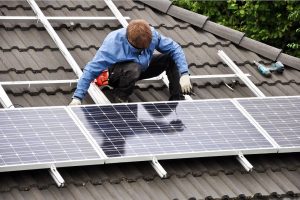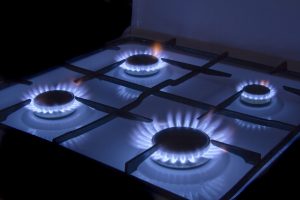[fusion_builder_container hundred_percent=”yes” overflow=”visible”][fusion_builder_row][fusion_builder_column type=”1_2″ last=”no” spacing=”yes” center_content=”no” hide_on_mobile=”no” background_color=”” background_image=”” background_repeat=”no-repeat” background_position=”left top” hover_type=”none” link=”” border_position=”all” border_size=”0px” border_color=”” border_style=”” padding=”” margin_top=”” margin_bottom=”” animation_type=”” animation_direction=”” animation_speed=”0.1″ animation_offset=”” class=”” id=””][fusion_text][fusion_dropcap color=”#000000″ boxed=”no” boxed_radius=”8px” class=”” id=””]A[/fusion_dropcap] photovoltaic (PV) system needs unobstructed access to the sun’s rays for most or all of the day to be effective. Shading on the system can significantly reduce energy output. Climate is not a major concern because PV systems are relatively unaffected by air temperatures, and snow cover typically melts quickly because panels are positioned directly into the sunlight. Abundant year-round sunshine makes solar energy systems useful and effective nearly everywhere in California.[/fusion_text][fusion_text]
The Size of Your Solar PV System
The size of your solar system depends on several factors such as how much electricity or hot water or space heat you use, the size of your roof, how much you’re willing to invest, and how much energy you want to generate. Contact a system designer/installer to determine what type of system fits your needs or use one of the Go Solar California online calculators to determine what system size will offer you the best financial payback.[/fusion_text][/fusion_builder_column][fusion_builder_column type=”1_2″ last=”yes” spacing=”yes” center_content=”no” hide_on_mobile=”no” background_color=”” background_image=”” background_repeat=”no-repeat” background_position=”left top” hover_type=”none” link=”” border_position=”all” border_size=”0px” border_color=”” border_style=”” padding=”” margin_top=”” margin_bottom=”” animation_type=”” animation_direction=”” animation_speed=”0.1″ animation_offset=”” class=”” id=””][fusion_separator style_type=”none” top_margin=”30px” bottom_margin=”” sep_color=”” border_size=”” icon=”” icon_circle=”” icon_circle_color=”” width=”” alignment=”center” class=”” id=””/][fusion_imageframe lightbox=”no” gallery_id=”” lightbox_image=”” style_type=”none” hover_type=”none” bordercolor=”” bordersize=”0px” borderradius=”0″ stylecolor=”” align=”left” link=”” linktarget=”_self” animation_type=”0″ animation_direction=”down” animation_speed=”0.1″ animation_offset=”” hide_on_mobile=”no” class=”” id=””]  [/fusion_imageframe][/fusion_builder_column][fusion_builder_column type=”1_1″ background_position=”left top” background_color=”” border_size=”” border_color=”” border_style=”solid” spacing=”yes” background_image=”” background_repeat=”no-repeat” padding=”” margin_top=”0px” margin_bottom=”0px” class=”” id=”” animation_type=”” animation_speed=”0.3″ animation_direction=”left” hide_on_mobile=”no” center_content=”no” min_height=”none”][fusion_title size=”2″ content_align=”left” style_type=”underline dashed” sep_color=”” margin_top=”” margin_bottom=”” class=”” id=””]Other Solar Technologies[/fusion_title][fusion_text]
[/fusion_imageframe][/fusion_builder_column][fusion_builder_column type=”1_1″ background_position=”left top” background_color=”” border_size=”” border_color=”” border_style=”solid” spacing=”yes” background_image=”” background_repeat=”no-repeat” padding=”” margin_top=”0px” margin_bottom=”0px” class=”” id=”” animation_type=”” animation_speed=”0.3″ animation_direction=”left” hide_on_mobile=”no” center_content=”no” min_height=”none”][fusion_title size=”2″ content_align=”left” style_type=”underline dashed” sep_color=”” margin_top=”” margin_bottom=”” class=”” id=””]Other Solar Technologies[/fusion_title][fusion_text]
- Concentrating solar power (CSP) systems concentrate the sun’s energy using reflective devices such as troughs or mirror panels to produce heat that is then used to generate electricity.
- Solar water heating systems contain a solar collector that faces the sun and either heats water directly or heats a “working fluid” that, in turn, is used to heat water.
- Transpired solar collectors, or “solar walls,” use solar energy to preheat ventilation air for a building.
[/fusion_text][/fusion_builder_column][/fusion_builder_row][/fusion_builder_container]



